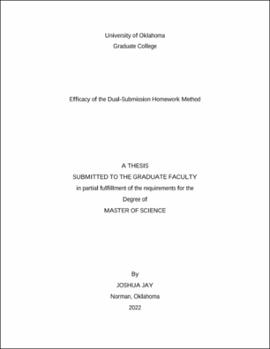| dc.description.abstract | The dual-submission homework method (DSHM) has become an increasingly popular form of
self-assessment in recent years due to its low-stress engagement for students and the reduction of
workload on instructors and students alike. However, to date, qualitative studies have been the
primary form of investigation to ascertain the effectiveness of the DSHM. The purpose of this
study is to investigate, with quantitative data, whether the dual-submission homework method
leads to an increase in learning comprehension and retention of the material by the participants
involved. Data collected from 59 students enrolled in a sophomore-level Digital Design course
for Electrical Engineering majors was the focal point of this study.
The single-submission homework method (SSHM) resembles the structure traditionally used in
classes. Students are assigned homework, to be submitted once, that will be graded based on
accuracy and completion. The DSHM assignment, however, features two distinct portions.
Students will complete their initial submission, which is graded based on effort and completion.
The solution key for a DSHM assignment is released by the instructor after the initial
submission. The students must then submit a corrected version of their initial assignment for the
second portion of their homework grade. This corrected submission is then graded on effort,
completion, and accuracy as well.
Subsequent exams included questions that closely resembled those from the SSHM and DSHM
assignments, respectively. Performance measures for this study included grades on homework
assignments and exams that were used to accurately measure the results of the DSHM compared
to the SSHM. Measured by performance on the aforementioned criteria, ANOVA analysis
demonstrated that student performance on DSHM exam-based questions was substantially
greater than SSHM exam-based questions. As seen in previous self-assessment studies, feedback
from participants and the course instructor indicated significant qualitative advantages to the
DSHM; desire for implementation in future courses and the reduction of workload and anxiety
about grades for instance. In essence, this study has provided the necessary quantitative and
qualitative evidence to indicate, at the very least, that the Dual-Submission Homework Method is
not a novelty concept and should be given serious consideration in implementation to the same
degree as the traditional single-submission homework method.
Keywords
Dual-submission, single-submission, homework, self-assessment, comprehension | en_US |
